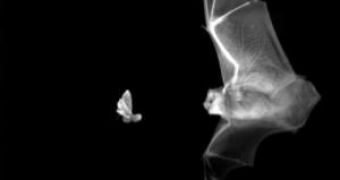Poisonous or distasteful animals are more efficient in defending themselves with their chemical weaponry but they can also warn of this. That's why many insects, poisonous frogs or coral snakes, for example, display their vivid colors.
But the method is so efficient with the predators, that many defenseless and tasty species mimic the color pattern of dangerous/distasteful animals.
Over 20 genera of non-venomous snakes mimic the extremely poisonous coral snakes. Many butterflies mimic the highly toxic Monarch and are left alone by insectivorous birds.
"Anecdotal observations have suggested that animals such as snakes, owls and bees use acoustic mimicry. This study takes the next step and provides the definitive experimental evidence for how mimicking sounds helps an animal survive." said Jesse Barber, a doctoral student in biology at Wake Forest, that led the 4 years study on the relation moths-bats.
Tiger moths can respond to the ultrasound sonar that bats use to locate prey with ultrasound clicks of their own, emitted by a pair of organs named "tymbals." The tiger moths warn with their ultrasounds the bats about their bad taste. But other moth species were found to mimic the ultrasounds of the toxic moths.
"We found that the bats do not eat the good-tasting moths that make the similar sounds," said Barber.
Other species of moths of similar size to the mimicking species, but which did not make sounds, were eaten by the bats. By using two high-speed infrared video cameras to see predator-prey interactions that take place in fractions of a second, the researchers watched free-flying bats interacting with the moths, while ultrasounds from both species were recorded.
All the bats learned fast to avoid the toxic moths based on their warning ultrasounds, but they also avoided a "false toxic" moth. The bats species involved in the research were big brown bat and red bat individuals raised in the lab so that behavior in the wilderness did not bias the experiment's result.

 14 DAY TRIAL //
14 DAY TRIAL //